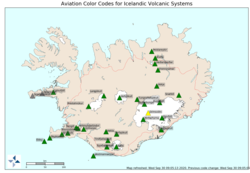The Aviation Color Code for Grímsvötn changed from green to yellow
The Icelandic Met Office has changed the aviation color code for Grímsvötn volcano from green to yellow. Volcanic activity at Grímsvötn has been gradually increasing over time as indicated by several regularly monitored geophysical and geochemical parameters that are now above the known background level:
- The seismicity during the past month has been above average
- Geothermal activity has increased over the past months with clear signs of deepening cauldrons in several places around the caldera
- The surface deformation has exceeded the level it was at prior to the 2011 eruption
- Magmatic gases were measured in the geothermal emissions this summer.
In addition, the water height in the subglacial lake is comparable to the level prior to the floods in 2004 and 2010, increasing the likelihood for a flood in the coming months.
Multiple datasets now indicate that Grímsvötn volcano has reached a level of unrest, comparable to that observed prior to historic eruptions.
For these reasons, the aviation color code has changed from green to yellow. This does not mean that an eruption is imminent. However, an eruption could be triggered by depressurization if the subglacial lake inside the caldera will drain and cause a flood or occur regardless, possibly with very weak precursory activity and short warning time, as seen in the eruption of 2011.
The conditions at the volcano may change at any given time and the volcano may return to normal background conditions without further escalation.
The Civil Protection meets regularly with the Icelandic Meteorological Office and is informed about the situation. So far, there are no reasons to change the alert level of civil protection due to Grímsvötn.
About the aviation color code system
As stated by the International Civil Aviation Organization ( ICAO ). The Aviation Color Code (ACC) system is operated by the State Volcano Observatory to alert and inform about the status of volcanic activity and it explicitly addresses airborne ash hazards. The users intended to receive such information are, in this sense, the Volcanic Ash Advisory Centres, the Meteorological Offices, the airlines companies and all those authorities in charge to take actions to mitigate the potential impact of an eruption on the aviation services (e.g. ISAVIA in Iceland). The volcano level of alert color codes for aviation are a key component of the global standardization of information provided by volcanological agencies to aviation users.
The Aviation Color Codesystem consists of four official levels: green, yellow, orange and red. The levels are applicable both when the volcano is showing increasing level of activity, which occasionally culminates into an eruption and when the volcano is going back to background conditions after an unrest or an eruption. The color assigned to each volcano is reviewed regularly and is changed to reflect the situation any time.
In the past years, the Aviation Color Code has been changed several times for few volcanoes in Iceland. The most recent ones have been for Reykjanes in January 2020, Öræfajökull in 2017, Katla in 2016 and Bárðarbunga in 2014-2015 in connection to the Holuhraun eruption. In few occasions, the aviation color code has been raised to orange/red; the most recent case was during the last eruption in Bárðarbunga.




